Richard Ehrlich: Backpackers Rescue Ancient Hoi An
Backpackers Rescue Ancient Hoi An
Hoi An, Vietnam -- Foreign backpackers and the United Nations have helped Vietnam's communists rescue this exquisite town, which became dilapidated after wealthy shippers and merchants abandoned it more than 100 years ago.
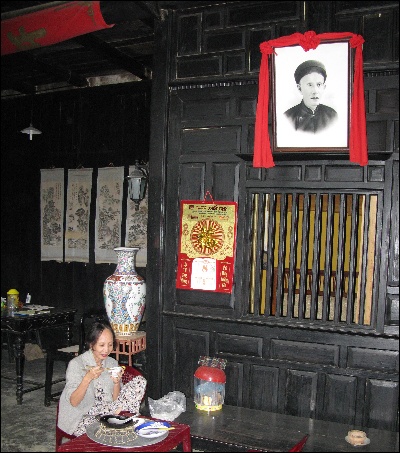
Exquisite homes honor the
people who built them hundreds of years ago, and still
provide shelter for residents today. Photo Credit: Photo ©
by Richard S. Ehrlich
This small port on central Vietnam's Thu Bon River began attracting big money in the 15th century, when East Asia's ships came to nestle, and procure fresh supplies.
By the 17th and 18th centuries, Hoi An was booming, luring British, French, Dutch, Portuguese, Chinese, Thai and Japanese vessels.
International merchants erected expensive, teak wood homes, graced with mother-of-pearl panels, porcelain, private courtyards, backyard docks, balconies and lattice-carved windows.

Women glue together
bamboo frames and wrap them in silk, hoping to sell the
popular lanterns to tourists. Photo Credit: Photo © by
Richard S. Ehrlich
Foreigners also built pagodas, temples, shrines and a legendary Japanese bridge.
Their opulent lifestyle, however, collapsed more than 100 years ago, when bigger and better port facilities opened in nearby, deep- water Danang.
Tiny Hoi An began decaying.
Its illustrious architecture suffered a lack of maintenance against seasonal typhoons, relentless heat, fungus-friendly humidity and poverty.
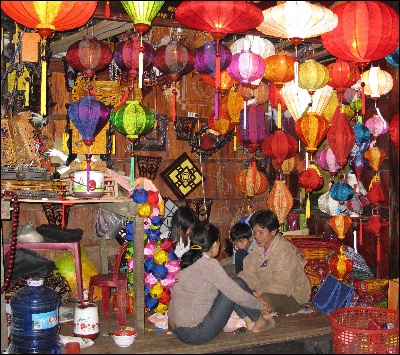
Tiny shops sell lanterns
and other locally-made decorative and handicraft items.
Photo Credit: Photo © by Richard S.
Ehrlich
Danang became a major U.S. military base after U.S. troops splashed ashore in 1965, at the start of America's failed 10-year- long war to crush communism in Vietnam.
But Hoi An was never seriously damaged during the war, despite its proximity.
In the early 1990s, Vietnam allowed foreign tourists into Hoi An.
Today, the town has emerged from ruin, and is being boosted as an elegant, romantic destination.
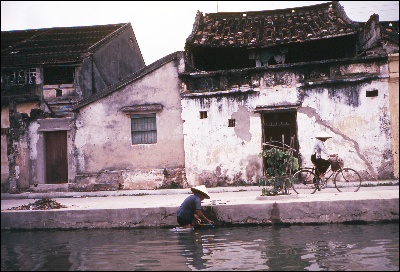
In 1993, after Vietnam
began allowing foreign travelers into Hoi An, the
riverside's antique buildings were bleak, faceless, peeling
hovels, devoid of commercial activity. Photo Credit: Photo
© by Richard S. Ehrlich
"South of Hanoi, it's probably the most visited city by Lonely Planet readers" traveling in Vietnam, said Josh Krist, who recently stayed in Hoi An to update the Vietnam chapter of a Lonely Planet guidebook titled, "Southeast Asia on a Shoestring."
"There's something about walking through the old city when it's lit up at night, with the bars in restored antique houses," Mr. Krist said in an e-mail interview.
"Hoi An attracts older [foreign] people too, and couples, because it's a very romantic city, so there's not that bar girl thing you get in other cities in Vietnam."
Hoi An's renaissance could falter if the global economy slumps.

At night, lanterns turn
riverside cafes and galleries into quaint, romantic places
to stroll. Photo Credit: Photo © by Richard S.
Ehrlich
"When the tourists stop coming, the locals are screwed. Like the bitch-goddess, 'success', 'tourism' is a fickle thing," Mr. Krist said.
"The town is one [major] bird flu scare away from emptying out."
Many of Hoi An's more than 60,000 residents have profited from the influx of tourists.
Others complain that the swarms of visitors have fueled inflation for food, services, and real estate with investors building more hotels, restaurants and other facilities.
Hoi An's original main street, Le Loi, forms a charming vein through cramped neighborhoods lined with quaint but surprisingly hip cafes, art galleries, and trendy showrooms offering Paris-inspired, hand-tailored silk fashions.
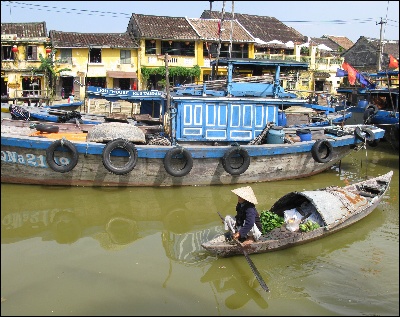
Spruced-up buildings
along the river have turned themselves into restaurants,
boutiques and other hip venues, while the only boats to
enter the harbor are small vessels. Photo Credit: Photo ©
by Richard S. Ehrlich
Dogs occasionally wander through some of Le Loi's restaurants, which serve a delicious traditional dish called "white rose," made of steamed white dumplings stuffed with tiny shrimp, cooked on wood- burning stoves.
The tourism industry also profits people engaged in making Hoi An's ubiquitous, hand-glued, silk-on-bamboo, hanging lanterns.
"Hoi An Ancient Town is an exceptionally well-preserved example of a Southeast Asian trading port dating from the 15th to the 19th century," the United Nations Educational, Scientific and Cultural Organization (UNESCO) said after listing it in 1999 as a World Heritage site.
"Its buildings and its street plan reflect the influences, both indigenous and foreign, that have combined to produce this unique heritage site," UNESCO said.
UNESCO earlier listed central Vietnam's nearby former imperial city, Hue, and also the northeast coastal region of Ha Long Bay as world heritage sites.
Hoi An's best surviving treasure, UNESCO noted, was its photogenic bridge.
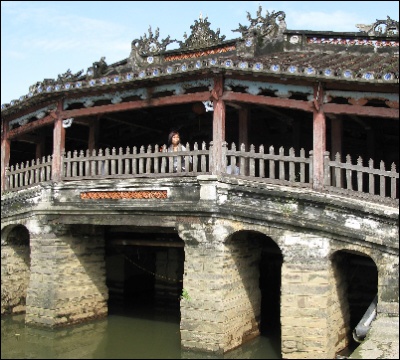
A woman gazes from the
Japanese Bridge, which superstitious people believe is heavy
enough to weigh down the vertebrae of a dragon-like monster.
Photo Credit: Photo © by Richard S.
Ehrlich
The small, covered Japanese bridge was constructed in the 17th century across a thin tributary in Hoi An's then-prosperous Japanese quarter.
Wood beams support the stone bridge's roof which is decorated with porcelain plates.
The bridge was built wide enough for a person to walk through, while carrying a shoulder-balanced bamboo pole from which two wicker baskets dangle -- the traditional way emaciated coolies moved goods.
The bridge also appeased a superstition which described the site as a weak vertebrae in the spine of a dragon-like beast which stretched across Asia, with its head in India and tail forming Japan.
The small but heavy bridge trapped the thrashing monster, preventing it from causing natural disasters in Hoi An, according to local lore.
ENDS
************
Richard S Ehrlich is a Bangkok-based journalist who has reported news from Asia since 1978. He is co-author of "Hello My Big Big Honey!", a non-fiction book of investigative journalism, and his web page is http://www.geocities.com/asia_correspondent


 Ramzy Baroud: No More 'Deals’ - What Palestinians Want And Will Fight To Achieve
Ramzy Baroud: No More 'Deals’ - What Palestinians Want And Will Fight To Achieve  Peter Dunne: Dunne's Weekly - Mayor Whanau's Rare Win - To Her City's Detriment
Peter Dunne: Dunne's Weekly - Mayor Whanau's Rare Win - To Her City's Detriment Binoy Kampmark: Ironic Dependency - Russian Uranium And The US Energy Market
Binoy Kampmark: Ironic Dependency - Russian Uranium And The US Energy Market Binoy Kampmark: Arrest Warrants From The Hague - The ICC, Netanyahu And Gallant
Binoy Kampmark: Arrest Warrants From The Hague - The ICC, Netanyahu And Gallant Ian Powell: General Practice Visits, Emergency Department Presentations, And Social Determinants Of Health
Ian Powell: General Practice Visits, Emergency Department Presentations, And Social Determinants Of Health Gordon Campbell: On The Hikoi Aftermath
Gordon Campbell: On The Hikoi Aftermath